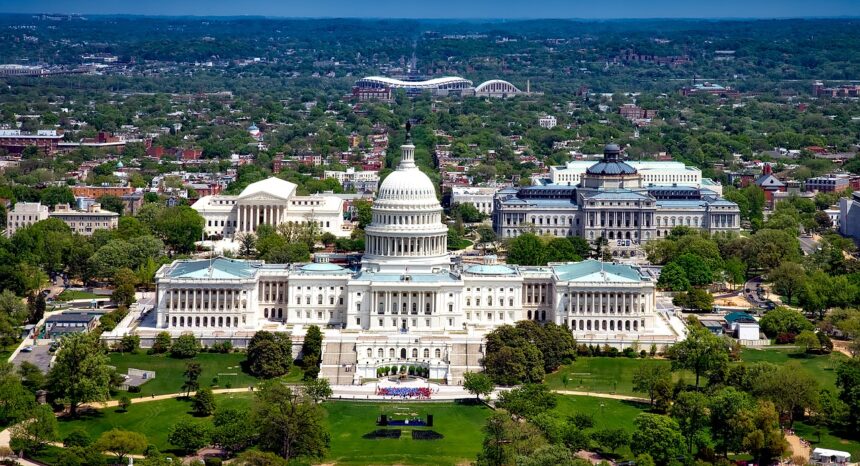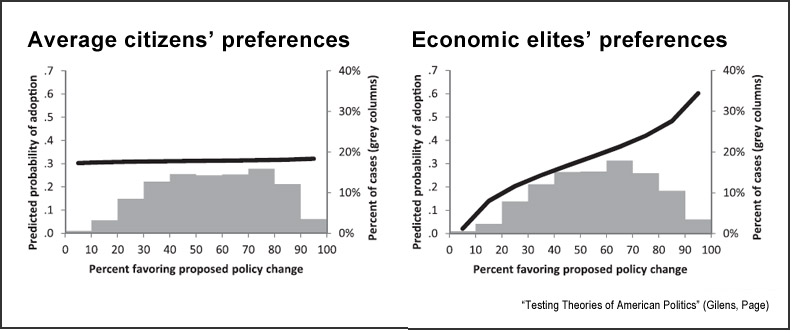
2014 study published in Perspectives on Politics analyzing the relative influence of economic elites, interest groups and voters on the passing of public policies.
by Martin Maximino | November 14, 2014
You are free to republish this piece both online and in print, and we encourage you to do so with the embed code provided below. We only ask that you follow a few basic guidelines.
by Martin Maximino, The Journalist's Resource
November 14, 2014
Public policy in the United States is shaped by a wide variety of forces, from polls and election results to interest groups and institutions, both formal and informal. In addition to political parties, the influence of diverse and sometimes antagonistic political forces has been widely acknowledged by policymakers and evidenced by scholars, and journalists. In recent years concerns have been growing that deep-pocketed donors now play an unprecedented role in American politics — concerns supported by 2013 research from Harvard and the University of Sydney that found that for election integrity, the U.S. ranked 26th out of 66 countries analyzed.
The question of who shapes public policies and under what conditions is a critical one, particularly in the context of declining voter turnout. From both a theoretical and practical point of view, it is important to understand if voters still have the possibility of providing meaningful input into public policies, or if the government bypasses citizens in favor of economic elites and interest groups with strong fundraising and organizational capacity.
A 2014 study published in Perspectives on Politics, “Testing Theories of American Politics: Elites, Interest Groups, and Average Citizens,” analyzes the relative influence of political actors on policymaking. The researchers sought to better understand the impact of elites, interest groups and voters on the passing of public policies. The authors, Martin Gilens of Princeton and Benjamin Page of Northwestern, based their research on a database of voters’ and interest groups’ positions on 1,779 issues between 1981 and 2002, and how those positions were or weren’t reflected in policy decisions.
The scholars use the data to examine four theoretical conceptions of how American politics works and the degree of influence that parties have on the decision-making process: (1) majoritarian electoral democracy, in which average citizens lead the decision-making process; (2) economic-elite domination; (2) majoritarian pluralism, in which mass-based interest groups provide the driving force; and (4) biased pluralism, where the opinions of business-oriented interest groups weigh most heavily.
The study’s key findings include:

“The central point that emerges from our research is that economic elites and organized groups representing business interests have substantial independent impacts on U.S. government policy, while mass-based interest groups and average citizens have little or no independent influence,” the scholars conclude, providing “substantial support” for the theories of economic-elite domination and biased pluralism.
Related research: A 2010 study by Jacob S. Hacker of Yale and Paul Pierson of University of California, Berkeley, “Winner-Take-All Politics: Public Policy, Political Organization and the Precipitous Rise of Top Incomes in the United States,” examines structural and political explanations for rising inequality. Further, a 2014 literature review, “Advancing the Empirical Research on Lobbying,” written by John M. de Figueiredo of Duke and Brian Kelleher Richter of the University of Texas, Austin, provides an overview of leading scholarship and suggests promising social science methods and new data sources. They find that lobbying expenditures at the federal level are approximately five times those of political action committee (PAC) campaign contributions. For instance, in 2012, organized interest groups spent $3.5 billion annually lobbying the federal government, compared to approximately $1.55 billion in campaign contributions from PACs and other organizations over the two-year 2011-2012 election cycle.
Keywords: public policy, interest groups, guns, corruption, organized labor, campaign fundraising